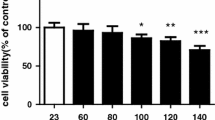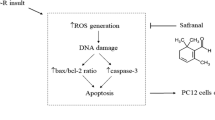Abstract
Diabetic neuropathy is one of the most frequent complications of diabetes. Despite some studies, the exact mechanism of glucose neurotoxicity has not been fully elucidated. Increased reactive oxygen species (ROS) has proposed as a possible mechanism. Crocus sativus L. (saffron) has been known as a source of antioxidants. Therefore, neuroprotective effect of saffron extract, its active component crocin and γ-glutamylcysteinylglycine (GSH) was studied in glucose-induced neurotoxicity, using PC12 cells as a suitable in vitro model of diabetic neuropathy. Cell viability was quantitated by MTT assay. ROS was measured using DCF-DA by flow cytometry analysis. The result showed that glucose (13.5 and 27 mg/ml) reduced the cell viability of PC12 cells after 4 days. Saffron extract (5 and 25 mg/ml), crocin (10 and 50 μM) and GSH (10 μM) could decrease this toxicity. Glucose toxicity was consistent with increased ROS production which reduced by saffron, crocin and GSH pretreatment. These results suggest saffron and its carotenoid crocin could be potentially useful in diabetic neuropathy treatment.




Similar content being viewed by others
References
Abe K, Sugiura M, Shoyama Y, Saito H (1998) Crocin antagonizes ethanol inhibition of NMDA receptor-mediated responses in rat hippocampal neurons. Brain Res 787(1):132–138
Assimopoulou AN, Sinakos Z, Papageorgiou VP (2005) Radical scavenging activity of Crocus sativus L. extract and its bioactive constituents. Phytother Res 19:997–1000
Aveccina HA (1998) A1-Qanun fi’l-Tibb English translation. Hamdard University, New Delhi, pp 241–242
Baynes JW (1991) Role of oxidative stress in development of complications in diabetes. Diabetes 40:405–412
Brownlee M (2001) Biochemistry and molecular cell biology of diabetic complications. Nature 414:813–820
Chen Y, Zhang H, Tian X, Zhao C, Cai L, Liu Y, Jia L, Yin HX, Chen C (2008) Antioxidant potential of crocins and ethanol extracts of Gardenia jasminoides Ellis and Crocus sativus L.: a relationship investigation between antioxidant activity and crocin contents. Food Chem 109:484–492
Greene DA, Sima AAF, Stevens MJ, Feldman EL, Lattimer SA (1992) Complications, neuropathy, pathogenetic considerations. Diabetes Care 15:1902–1925
Greene DA, Stevens MJ, Obrosova I, Feldman EL (1999) Glucose-induced oxidative stress and programmed cell death in diabetic neuropathy. Eur J Pharmacol 375:217–223
Hosseinzadeh H, Younesi HM (2002) Antinociceptive and anti-inflammatory effects of Crocus sativus L. stigma and petal extracts in mice. BMC Pharmacol 2:7
Keyhani E, Ghamsari I, Keyhani J, Hadizadeh M (2006) Antioxidant enzymes during hypoxia-anoxia signaling events in Crocus sativus L. corm. Ann NY Acad Sci 1091:65–75
LeBel CP, Ischiropoulos H, Bondy SC (1992) Evaluation of the probe 2′, 7′-dihydrodichlorofluorescein as an indicator of reactive oxygen species formation and oxidative stress. Chem Res Toxicol 5:227–231
Leclerc L (1883) Le Trité des simples par Ibn el-Beï thar in Notices et Extraits des Manuscrits de la Bibliothéque Nationale et autres ibliothéques, Tome 25, pp 208–210. L’Institut National de France, Paris, FrancePhytother Res 19:997–1000
Mousavi SH, Tavakkol-Afshari J, Brook A, Jafari-Anarkooli I (2009) Direct toxicity of Rose Bengal in MCF-7 cell line: role of apoptosis. Food Chem Toxicol 47:855–859
Nair SC, Kurumboor SK, Hasegawa JH (1995) Saffron chemoprevention in biology and medicine, a review. Cancer Biother 10:257–264
Nishikawa T et al (2000) Normalizing mitochondrial superoxide production blocks three pathways of hyperglycaemic damage. Nature 404:787–790
Oberley LW (1998) Free radicals and diabetes. Free Radic Biol Med 5:113–124
Ochiai T, Ohno S, Soeda S, Tanaka H, Shoyama Y, Shimeno H (2004) Crocin prevents the death of rat pheochromyctoma (PC-12) cells by its antioxidant effects stronger than those of a-tocopherol. Neurosci Lett 362:61–64
Ochiai T, Shimeno H, Mishima K, Iwasaki K, Fujiwara M, Tanaka H, Shoyama Y, Toda A, Eyanagi R, Soeda S (2007) Protective effects of carotenoids from saffron on neuronal injury in vitro and in vivo. Biochim Biophys Acta: General Subjects 1770:578–584
Okouchi M, Okayama N, Aw TY (2005) Hyperglycemia potentiates carbonyl stress-induced apoptosis in naive PC-12 cells, relationship to cellular redox and activator protease factor-1 expression. Curr Neurovasc Res 2:375–386
Osen P, Nawroth PP, King G, Ller W, Tritschler HJ, Packer L (2001) The role of oxidative stress in the onset and progression of diabetes and its complications, a summary of a congress series sponsored by UNESCO-MCBN, the American diabetes association and the German diabetes society. Diabetes Metab Res Rev 17:189–212
Palozza P, Krinsky NI (1992) Antioxidant effects of carotenoids in vivo and in vitro, an overview. Meth Enzymol 213:403–420
Pellegrini N, Serafini M, Salvatore S, Rio DD, Bianchi M, Brighenti F (2006) Total antioxidant capacity of spices, dried fruits, nuts, pulses, cereals and sweets consumed in Italy assessed by three different in vitro assays. Mol Nutr Food Res 50:1030–1038
Rhazes MZ (1968) Kitabu’l Hawi fi’t-Tibb vol 20 part. 2. Osmania Oriental publications Bureau, Osmania University, Hyderabad-7, pp 548–553 (in Arabic)
Rvos JL, Recio MC, Giner RM, Manez S (1996) An update review of saffron and its active constituents. Phytother Res 10:189–193
Shi H, Liu KJ (2006) Effects of glucose concentration on redox status in rat primary cortical neurons under hypoxia. Neurosci Lett 13(410(1)):57–61
Tavakkol Afshari J, Brook A, Mousavi SH (2008) Study of cytotoxic and apoptogenic properties of saffron extract in human cancer cell lines. Food Chem Toxicol 46:3443–3447
Tomlinson DR, Gardiner NJ (2008) Glucose neurotoxicity. Nat Rev Neurosci 9:36–45
Vincent AM, Russell JW, Low P, Feldman EL (2004) Oxidative stress in the pathogenesis of diabetic neuropathy. Endocr Rev 25:612–628
Wallach-Dayan SB, Izbicki G, Cohen PY, Gerstl-Golan R, Fine A, Breuer R (2006) Bleomycin initiates apoptosis of lung epithelial cells by ROS but not by Fas/FasL pathway. Am J Physiol Lung Cell Mol Physiol 290:L790–L796
Wolff SP, Jiang ZY, Hunt JV (1991) Protein glycation and oxidative stress in diabetes mellitus and ageing. Free Radic Biol Med 10:339–352
Zaltzberg H, Kanter Y, Aviram M, Levy Y (1999) Increased plasma oxidizability and decreased erythrocyte and plasma antioxidative capacity in patients with NIDDM. Isr Med Assoc J 1:228–231
Zhang XD, Gillespie SK, Hersey P (2004) Staurosporine induces apoptosis of melanoma by both caspase-dependent and independent apoptotic pathways. Mol Cancer Ther 3:187–197
Zimmet P, Alberti KGMM, Shaw J (2001) Global and societal implications of the diabetes epidemic. Nature 414:782–787
Acknowledgments
The authors would like to thank Research Affairs of Mashhad University of Medical Sciences for financially supporting this work and Miss Aghaee for her assistance in preparation of saffron extract.
Author information
Authors and Affiliations
Corresponding author
Rights and permissions
About this article
Cite this article
Mousavi, S.H., Tayarani, N.Z. & Parsaee, H. Protective Effect of Saffron Extract and Crocin on Reactive Oxygen Species-Mediated High Glucose-Induced Toxicity in PC12 Cells. Cell Mol Neurobiol 30, 185–191 (2010). https://doi.org/10.1007/s10571-009-9441-z
Received:
Accepted:
Published:
Issue Date:
DOI: https://doi.org/10.1007/s10571-009-9441-z




